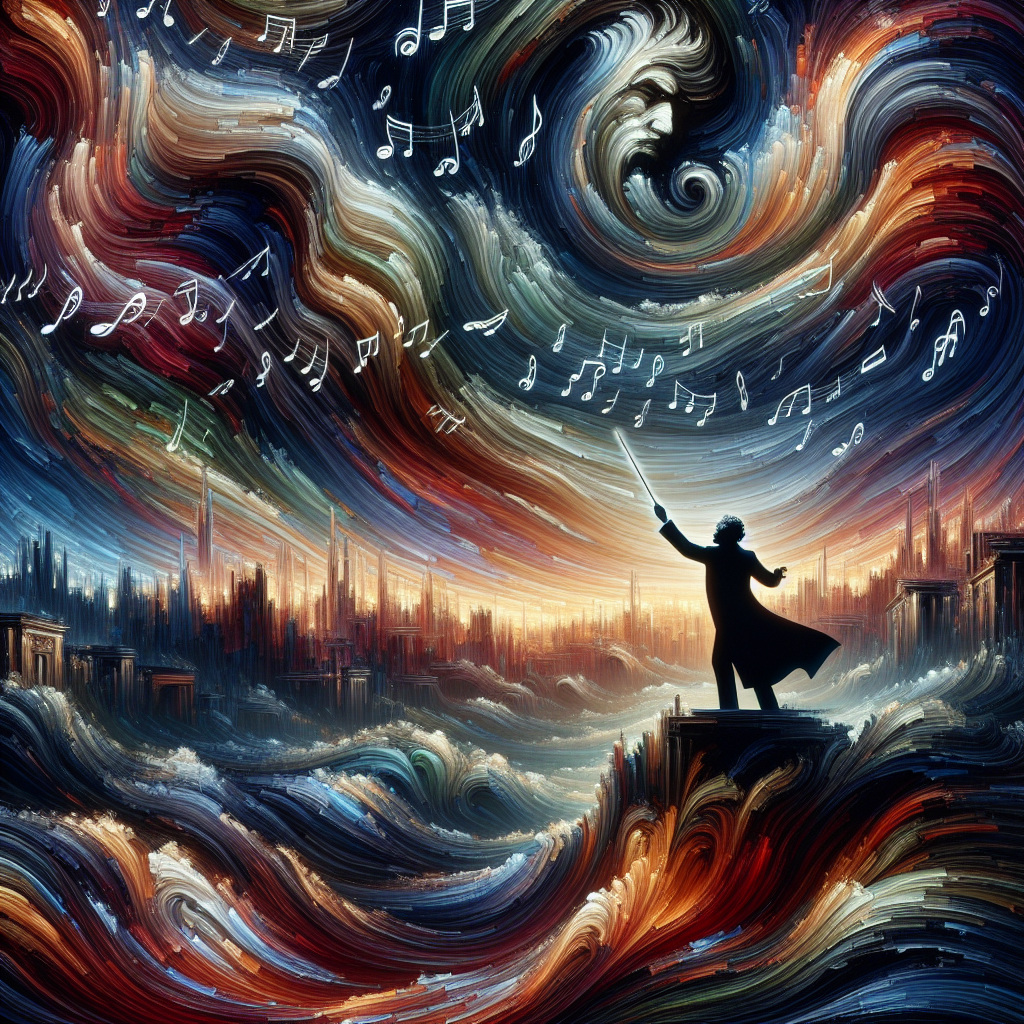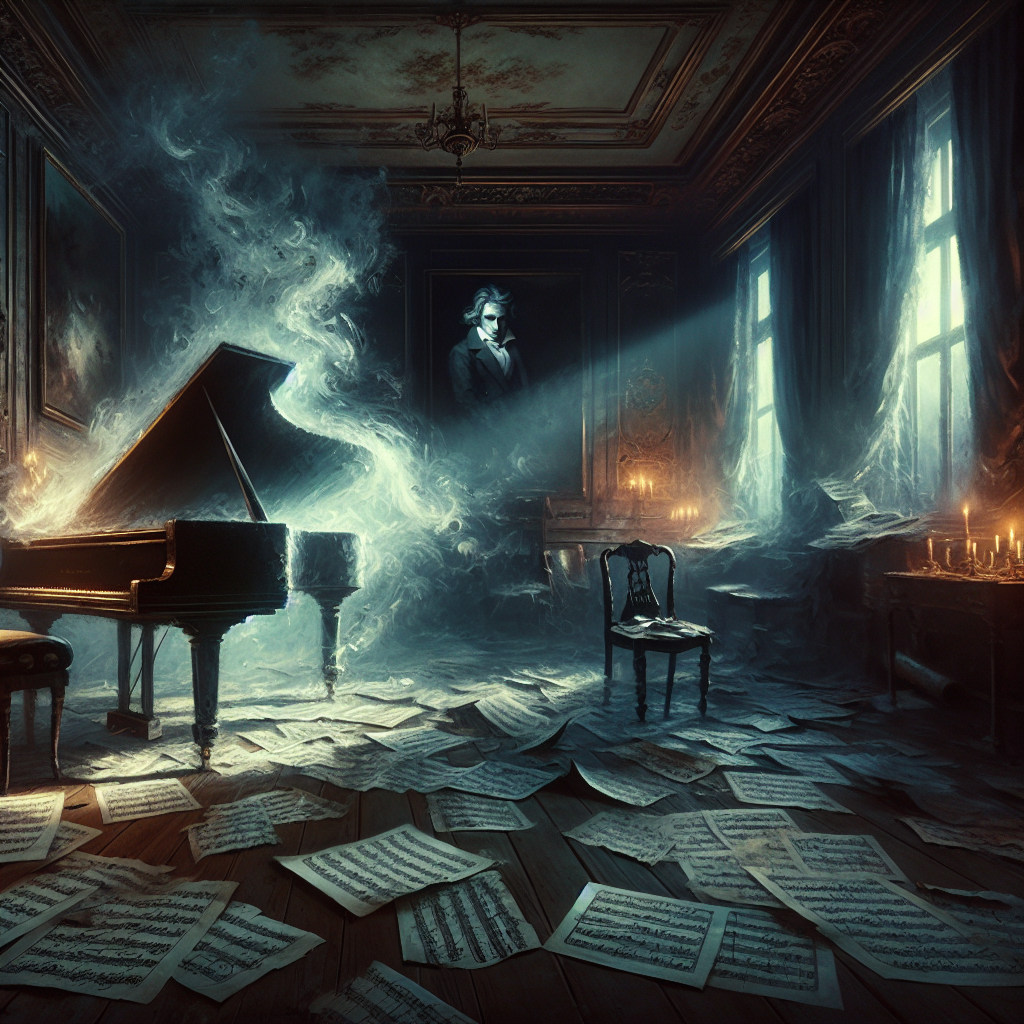
The Visual Arts and Beethoven: Depictions and Inspirations
Ludwig van Beethoven, a name that resonates profoundly in the world of classical music, not only made an indelible mark in his own medium, but also served as a muse and subject in other artistic forms, most notably the visual arts. His life, shrouded in both personal struggles and musical triumphs, has ignited the imaginations of countless painters, sculptors, and illustrators. These visual representations have helped cement Beethoven’s legacy in our cultural consciousness, allowing those who may never have heard his music to still feel connected to his genius.
From his early days in Bonn to his final moments in Vienna, Beethoven’s complex personality and physical transformation were captured by contemporaneous artists. His commanding presence, characterized by his unkempt hair and intense gaze, has become iconic, immortalized in numerous portraits and sculptures. These visual pieces are not merely representations of his physical form but are windows into the turbulent life he led and the unequivocal perseverance that underscored his creativity.
Furthermore, the artists who depicted Beethoven were themselves influenced by prevailing artistic movements and the cultural atmosphere of their times. They sought to capture not just a likeness, but also the essence of a man who changed the course of music history. Through various art forms, including paintings, etchings, and more modern interpretations, these depictions stand as a testament to Beethoven’s influence that transcends beyond music into the broader realm of cultural and artistic significance.
This article delves into the intersection of visual arts and Beethoven, exploring the influential personalities who shaped his artistic representation, the evolving portrayal of his image, and the broader cultural impacts of these artistic endeavors. We will examine not only who depicted Beethoven but also how these visual interpretations influence our modern understanding of this monumental figure.
The Early Depictions: Capturing Beethoven’s Youth and Ambition
The earliest visual depictions of Ludwig van Beethoven date back to his years in Bonn, where his musical promise began to shine. One of the most significant early portraits is that by an unknown artist, believed to have been painted around 1787. This painting shows a young Beethoven with a clear, determined gaze, hinting at the prodigious talent that was soon to take Europe by storm. Even in these early years, the intensity of Beethoven’s persona was palpable.
As Beethoven’s reputation grew, artists who worked in his vicinity found themselves drawn to his character. One notable example is the work of Christian Horneman, a Danish painter who portrayed Beethoven in 1803. This portrait is celebrated for its fresh, youthful appearance, showing Beethoven as he was beginning to make a name for himself in Vienna. His face is smooth, and his eyes are thoughtful, reflecting an optimistic future filled with potential.
In these early depictions, we can see a common thread: the portrayal of a driven, passionate young man on the brink of greatness. The visual arts from this period provide a stark contrast to later depictions, which would reveal more of the turmoil and hardship that Beethoven endured. For contemporary audiences, these portraits are valuable as they offer a glimpse into the early motivators of Beethoven’s career and his initial steps into the world of classical music.
The early visual representations of Beethoven thus act as historical documents, capturing a moment in time when Beethoven’s spirit was as yet unencumbered by the severe disappointments and health ailments that would later shape his life and work. The artists of this period managed to encapsulate the burgeoning genius of a young man, preserving it for future generations to witness.

Middle Years: The Rise of the Composer and the Artist’s Eye
As Beethoven’s musical prowess continued to evolve, so did the complexity and themes of the visual representations of him. During the middle period of his life, portraits and other artistic depictions began to reveal more about his emerging struggles and the intensity of his creative passion. Beethoven moved beyond mere promise to assured genius, a transformation masterfully captured by several prominent artists of the time.
One of the most famous portraits from this period is by Joseph Karl Stieler, painted around 1820. This iconic image of Beethoven is perhaps the most recognizable, showing him with a formidable expression, wild hair, and a determined look as he holds the manuscript of the “Missa Solemnis.” Stieler’s portrait is lauded not just for its likeness but for the palpable sense of intensity and seriousness it conveys, indicative of Beethoven’s demeanor during his middle years.
Another significant artist who captured Beethoven during his most productive middle years was Ferdinand Georg Waldmüller. Waldmüller’s etchings and sketches provide a different perspective, emphasizing the physical transformation of Beethoven as he aged and struggled with deafness and other ailments. These works present a man deeply immersed in his art, his brows furrowed in concentration, often with musical scores visible alongside him.
These middle-period pieces explore not just the appearance of Beethoven but also his evolving mythos as a tortured genius. The shift in how artists portrayed him—from a youthful prodigy to a brooding, intense figure battling personal demons—mirrors the depth and complexity of his compositions during this time. Each brushstroke, each etched line, offers insight into the world of a man grappling with both unprecedented creative success and profound personal suffering.
The Later Years: Struggles and Immortalization
The later years of Beethoven’s life were fraught with personal difficulties, health issues, and increasing isolation due to his worsening deafness. Yet, these hardships also brought about some of his most profound musical works, including the Ninth Symphony. Artists in this period depicted Beethoven with an acute sense of his struggles and resilience, creating portrayals that would come to define his posthumous legacy.
The visual representations from Beethoven’s later years often focused on the vulnerabilities and physical changes that defined this final chapter of his life. Notable among these is the 1823 bust by Franz Klein, which shows Beethoven with a resolute yet weary expression. Klein’s bust captures the physical toll of years of relentless work and suffering, encapsulating the inner fortitude of the composer who continued to create despite overwhelming challenges.
Another key figure in this period was the artist Friedrich von Amerling, whose 1827 portrait of Beethoven offers a more introspective view. Amerling’s painting emphasizes Beethoven’s profound inner world, portraying him in a somewhat melancholic state, introspective and perhaps resigned yet unyielding in spirit. The detailing in Amerling’s work, from the furrowed brow to the thoughtful eyes, speaks volumes about the psychological and emotional landscape of Beethoven’s later years.
The persistence of artists in capturing Beethoven’s likeness in his later years contributed significantly to the mythologizing of his image. Each representation from this period carries a sense of reverence and gravitas, acknowledging not just Beethoven’s musical genius, but also his monumental personal struggles. These visual depictions are a crucial part of how modern audiences perceive and understand the legacy of one of classical music’s greatest figures.
Influential Contemporaries and Their Works
Beethoven didn’t live in isolation; he was very much a part of the vibrant artistic and cultural milieu of his time. This period was marked by a confluence of great musical and artistic minds, and Beethoven’s relationships with his contemporaries often found reflection in visual art forms. Famous artists of the age took on his likeness and philosophy, ensuring that his image spread far and wide.
One of the most influential contemporaries was Johann Nepomuk Hummel, a composer and pianist whose interactions with Beethoven were both competitive and mutually respectful. Hummel’s students and followers produced a number of sketches and drawings that captured moments of their engagement, shedding light on how these two musical giants viewed each other.
Another significant figure was Franz Schubert, who idolized Beethoven and was famously pallbearer at his funeral. Although Schubert left us primarily with musical tributes, his reverence for Beethoven also inspired artists of the time to depict scenes of imagined interactions between the two, often signifying a passing of the musical torch. These pieces, though sometimes romanticized, provide a visual narrative of the mentorship and inspiration that shaped the evolution of Western classical music.
Artists like Ferdinand Ries, a student of Beethoven, also played a crucial role in shaping the visual narrative of Beethoven’s life. Ries’s personal impressions often informed the details that went into portraits, offering another layer of authenticity and personal touch to the images created during and even after Beethoven’s lifetime.
Modern Interpretations: Beethoven in Contemporary Visual Arts
In contemporary times, Beethoven’s influence remains undiminished, and his visage continues to inspire modern artists. Today, visual art forms ranging from traditional paintings to digital media and installations offer fresh perspectives on this towering figure. Modern interpretations of Beethoven often transcend mere portraiture, delving into more abstract and conceptual representations.
Contemporary artist Julian Schnabel’s expansive and often tumultuous paintings reimagine Beethoven by blending historical references with modern techniques. Schnabel’s works challenge the viewer to engage with Beethoven beyond his historical persona, probing into the emotional and experiential impact of his music. Similarly, Anselm Kiefer’s installations invoke the grandeur and the tragic elements of Beethoven’s life, utilizing materials like lead and broken glass to symbolize the weight and fragmentation of his experiences.
Street artists and illustrators have also paid homage to Beethoven, making his image accessible to a broader audience. Murals and graffiti bearing his likeness can be found in cities worldwide, juxtaposing classical themes with urban environments and modern issues. These works often use bold colors and graphic styles to capture the raw energy and revolutionary spirit Beethoven brought to his music.
Digital artists and animators are exploring Beethoven in new dimensions, creating animated portraits and VR experiences that allow audiences to interact with his life and music in immersive ways. These modern artistic efforts ensure that Beethoven’s legacy remains dynamic and relevant, connecting him with newer generations in novel and engaging manners.
Conclusion
The intricate relationship between Ludwig van Beethoven and the visual arts provides a multidimensional view of a complex and brilliant personality. From early depictions of his youthful ambition to the solemn portrayals of his later years, visual art offers a profound insight into the man behind the music. Each era’s representations form a narrative thread that helps us understand the evolving perception of Beethoven, not just as a composer, but as a monumental cultural icon.
His contemporaries and the artists who followed contributed significantly to the mythos of Beethoven, preserving not only his likeness but also the essence of his character and spirit. Through these works, we catch glimpses of the personal trials and achievements that shaped his music, painting a fuller picture of his life and times. The artistic interplay between these two realms enriches our appreciation of Beethoven, showing that his impact extends far beyond the auditory and into the visual and emotional landscapes of human experience.
Modern interpretations and contemporary artistic endeavors continue to keep Beethoven’s legacy alive, ensuring that his story remains relevant and inspiring. Whether through traditional mediums or cutting-edge technology, the ongoing fascination with Beethoven ensures that his image and spirit endure. This continuous engagement across artistic disciplines highlights the timeless nature of Beethoven’s genius and the universal resonance of his life story.
As we continue to explore the visual representations of Beethoven, we are reminded that art in all its forms is a powerful tool for connection, understanding, and inspiration. Through the lenses of painters, sculptors, and modern digital artists, the life and legacy of Ludwig van Beethoven are continually renewed, allowing each generation to rediscover and revere this unparalleled maestro anew.